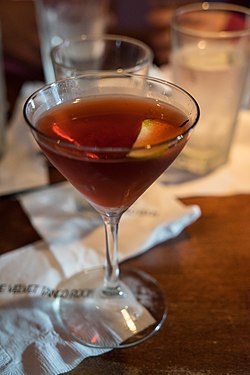Boulevardier (cocktail)
| IBA official cocktail | |
|---|---|
 | |
| Type | Cocktail |
| Base spirit | |
| Served | Straight up:chilled, without ice |
| Standard garnish | Orangezest, optionally a lemon zest |
| Standard drinkware | |
| IBAspecified ingredients† |
|
| Preparation | Pour all ingredients into mi xing glass with ice cubes. Stir well. Strain into a chilled cocktail glass. |
| †Boulevardier recipeatInternational Bartenders Association | |
Theboulevardiercocktailis an alcoholic drink composed ofwhiskey,sweetvermouth,andCampari.[1]It originated as an obscure cocktail in late 1920s Paris, and was largely forgotten for 80 years, before being rediscovered in the late 2000s as part of thecraft cocktail movement,rapidly rising in popularity in the 2010s as a variant of thenegroni,and becoming anIBA official cocktailin 2020.
History[edit]
The boulevardier first appeared in print in the Parisian cocktail bookBarflies and Cocktails(1927), where it is ascribed toErskine Gwynne,an American-born writer who founded a monthly magazine in Paris calledBoulevardier,which appeared from 1927 to 1932.[1][2][a]The cocktail appears, not in the main list of recipes, but in the essay "Cocktails About Town" byArthur Moss,which describes cocktails by men-about-town. The boulevardier is described as an equal parts cocktail:[5]
- Now is the time for all good Barflies to come to the aid of the party, since Erskinne [sic] Gwynne crashed in with his Boulevardier Cocktail; 1/3 Campari, 1/3 Italian vermouth, 1/3 Bourbon whisky.
The very similar "Old Pal"cocktail appears in the same essay, differing only in using Canadian Club whisky, rather than bourbon.[6]
The boulevardier did not catch on: no references to it have been found to it in cocktail books between 1927 and 2007, and it is absent from major collections.[7][8]This contrasts with the Old pal, which appeared in the main list of recipes in later editions of MacElhone, such asMacElhone (1952),and was well-known enough to be one of the 50 cocktails in the inaugural 1961 list ofIBA official cocktails.This also contrasts with the negroni, which only appeared in the late 1940s, but became popular in the 1950s[8]and also appeared in the 1961 IBA list.
The cocktail was rediscovered and popularized first by Ted Haigh, later by others,[7][8]starting with an article in the 2007 March/April issue ofImbibe,writing as "Dr. Cocktail".[9][10]Haigh subsequently published a recipe inHaigh (2009a),[11]together with further articles.[12]The cocktail was further popularized by Paul Clarke, who learned about it from Haigh,[9]and then published recipes onSerious Eats[13]andClarke (2015).The boulevardier was still rare in the early 2010s,[4]but by the mid-2010s was popular.[1]
The boulevardier was listed as anIBA official cocktailstarting in the 2020 list, in the "Unforgettables" section.[14]
Similar drinks[edit]
TheOld palis a similar contemporary cocktail, appearing in the same essay inMacElhone (1927),originally differentiated by using rye whiskey (Canadian Club) instead of bourbon (otherwise identical equal parts cocktails with Italian vermouth and Campari). It is now distinguished primarily by using dry "French" vermouth instead of sweet "Italian" vermouth; the IBA recipes also differ as equal parts (1:1:1) instead of the boulevardier's 1½:1:1 (3:2:2) and the whiskey always being rye, instead of bourbon or rye.
The boulevardier is similar to aNegroni,sharing two of its three ingredients. It is differentiated primarily by its use ofbourbon whiskeyorrye whiskeyas its principal component instead of gin.[15][16]In the IBA standard recipes it is also distinguished by being servedstraight up(no ice, stemmed glass) instead of down on the rocks (ice, tumbler); having more spirit than other components (1½:1:1), instead of having equal parts; and being garnished with an orange twist, rather than an orange slice. All of these other than whiskey vs. gin vary in specific recipes, however.
Variations[edit]
Recipes vary the proportions of its components. The original 1927 recipe is equal parts (1:1:1), but Haigh's 2007 revival is 3:2:2, calling for1+1/2parts rather than 1 part whiskey, and these are the proportions used in the IBA standard and many boulevardier recipes.[15][4]Others are heavier still (2:1:1), and call for two parts bourbon to one part vermouth and one part Campari.[17]
Notes[edit]
- ^Upon launching the magazine, which was apparently both humorous and literary, Gwynne said it would be "fast but clean".[3]The magazine published advertisements seeking subscribers in bothHarry's ABC of Mi xing Cocktails(1919, revised annually) andBarflies and Cocktails(1927, p. 111), the memoir and recipe collections ofHarry MacElhoneof Harry's New York Bar in Paris. MacElhone credited Gwynne, one of his regular customers, with inventing the drink.[4]
References[edit]
- ^abcSimonson, Robert(28 January 2014)."The Boulevardier Is Back on the Menu".The New York Times.Retrieved19 April2016.
- ^"Erskine Gwynne, 49, Wrote Book on Paris"(PDF).The New York Times.6 May 1948.Retrieved19 April2016.
- ^James, Edwin L. (20 February 1927)."Events of the Week Stir French Pride"(PDF).New York Times.Retrieved19 April2016.
- ^abcCecchini, Toby (2 February 2012)."Case Study: The Boulevardier".T.Retrieved7 November2015.
- ^MacElhone 1927,p. 80.
- ^MacElhone 1927,p. 82.
- ^abArmin (14 May 2017)."Boulevardier".Bar-Vademecum.
- ^abcFelten, Eric (21 April 2022)."Mysteries of the boulevardier and Negroni, solved".Washington Examiner.
- ^abPaul Clarke (4 October 2007)."Boulevardier".The Cocktail Chronicles.
- ^"Kinda like a Negroni...kinda like a Manhattan..."Dr. Bamboo.29 February 2008.
- ^Haigh 2009a,pp.75–76.
- ^Haigh, Ted (4 December 2009)."History Lesson: The Boulevardier".Imbibe.
- ^Clarke, Paul."Boulevardier".Serious Eats.
- ^Jacquelyn (16 April 2020)."The New 2020 IBA Cocktail List. The Quest (modified)".Wild and Wanderful Travel.
- ^ab"Boulevardier Cocktail".Imbibe Magazine.Retrieved19 April2016.
- ^Clarke, Paul."Boulevardier".Serious Eats.Retrieved19 April2016.
- ^Simonson, Robert."Boulevardier".The New York Times.Retrieved19 April2016.
- MacElhone, Harry(1919).Harry's ABC of mi xing cocktails.London: Dean & Son.
- MacElhone, Harry(1927).Barflies and Cocktails.Lecram Press, Paris.
- MacElhone, Harry(1952) [1919].Harry's ABC of mi xing cocktails(New ed.). London: Dean & Son.
- Haigh, Ted (2009).Vintage Spirits and Forgotten Cocktails: From the Alamagoozlum to the Zombie 100 Rediscovered Recipes and the Stories Behind Them.
- Clarke, Paul (2015) [2014].The Cocktail Chronicles: Navigating the Cocktail Renaissance with Jigger, Shaker & Glass.Spring House Press.ISBN978-1940611174.

